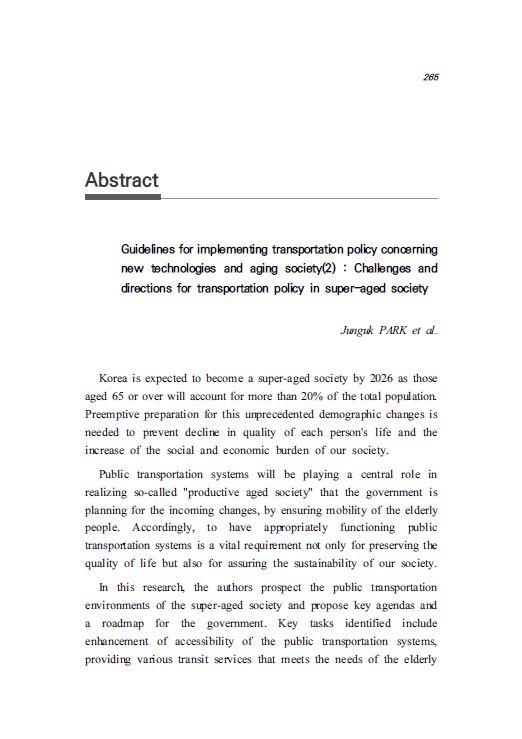General Research

RESEARCH
KOTI - Korea Transport institute
Guidelines for implementing transportation policy concerning new technologies and aging society(2) : Challenges and directions for transportation policy in super-aged society
- Date
December 31 2015
- Page(s)
page(s)
#Aged society
#public transportation
#population change
#public transportation access system
#public

Korea is expected to become a super-aged society by 2026 as those aged 65 or over will account for more than 20% of the total population. Preemptive preparation for this unprecedented demographic changes is needed to prevent decline in quality of each person's life and the increase of the social and economic burden of our society.
Public transportation systems will be playing a central role in realizing so-called "productive aged society" that the government is planning for the incoming changes, by ensuring mobility of the elderly people. Accordingly, to have appropriately functioning public transportation systems is a vital requirement not only for preserving the quality of life but also for assuring the sustainability of our society. In this research, the authors prospect the public transportation environments of the super-aged society and propose key agendas and a roadmap for the government. Key tasks identified include enhancement of accessibility of the public transportation systems, providing various transit services that meets the needs of the elderly people, and fare-scheme restructuring for the aged population. For the issues related to accessibility for public transport, authors proposed three measures such as improving pedestrian mobility system required to access public transport, improving mobility services within public transport facilities and introducing micro-mobility as a means of public transport. In addition, restructuring information provisions within public transport facilities for enhancing mobility for elderly people and improving station design to enhancing user connivence at spoke and nodes of public transport.
For the issues related to management system for public transport, the authors suggested improving measure for welfare-mobility by diversifying operators, rationalize financial subsidies, and systemizing management systems focused on public bus and taxis in rural area, demand responsive mode, designated transport mode for disabled person, and special care services. Also, authors suggested to introduce new types of transport services including imposing minimum public transport service level and allowing personal vehicle to utilize as a public transport.
For the issues related to fare level, authors suggested measures to balancing out the differences in fare levels between bus and metro, to separate financial subsidy schemes for intra urban from inter regional in response to the claim that the receiving parties of the subsidies vary, and to claim the need for legal ground for supporting regionally and economically vulnerable people. Along with these policy measures, the authors reviewed financing schemes in conjunction with revision of legal framework for soothing financial burden for supporting public transport.
Public transportation systems will be playing a central role in realizing so-called "productive aged society" that the government is planning for the incoming changes, by ensuring mobility of the elderly people. Accordingly, to have appropriately functioning public transportation systems is a vital requirement not only for preserving the quality of life but also for assuring the sustainability of our society. In this research, the authors prospect the public transportation environments of the super-aged society and propose key agendas and a roadmap for the government. Key tasks identified include enhancement of accessibility of the public transportation systems, providing various transit services that meets the needs of the elderly people, and fare-scheme restructuring for the aged population. For the issues related to accessibility for public transport, authors proposed three measures such as improving pedestrian mobility system required to access public transport, improving mobility services within public transport facilities and introducing micro-mobility as a means of public transport. In addition, restructuring information provisions within public transport facilities for enhancing mobility for elderly people and improving station design to enhancing user connivence at spoke and nodes of public transport.
For the issues related to management system for public transport, the authors suggested improving measure for welfare-mobility by diversifying operators, rationalize financial subsidies, and systemizing management systems focused on public bus and taxis in rural area, demand responsive mode, designated transport mode for disabled person, and special care services. Also, authors suggested to introduce new types of transport services including imposing minimum public transport service level and allowing personal vehicle to utilize as a public transport.
For the issues related to fare level, authors suggested measures to balancing out the differences in fare levels between bus and metro, to separate financial subsidy schemes for intra urban from inter regional in response to the claim that the receiving parties of the subsidies vary, and to claim the need for legal ground for supporting regionally and economically vulnerable people. Along with these policy measures, the authors reviewed financing schemes in conjunction with revision of legal framework for soothing financial burden for supporting public transport.